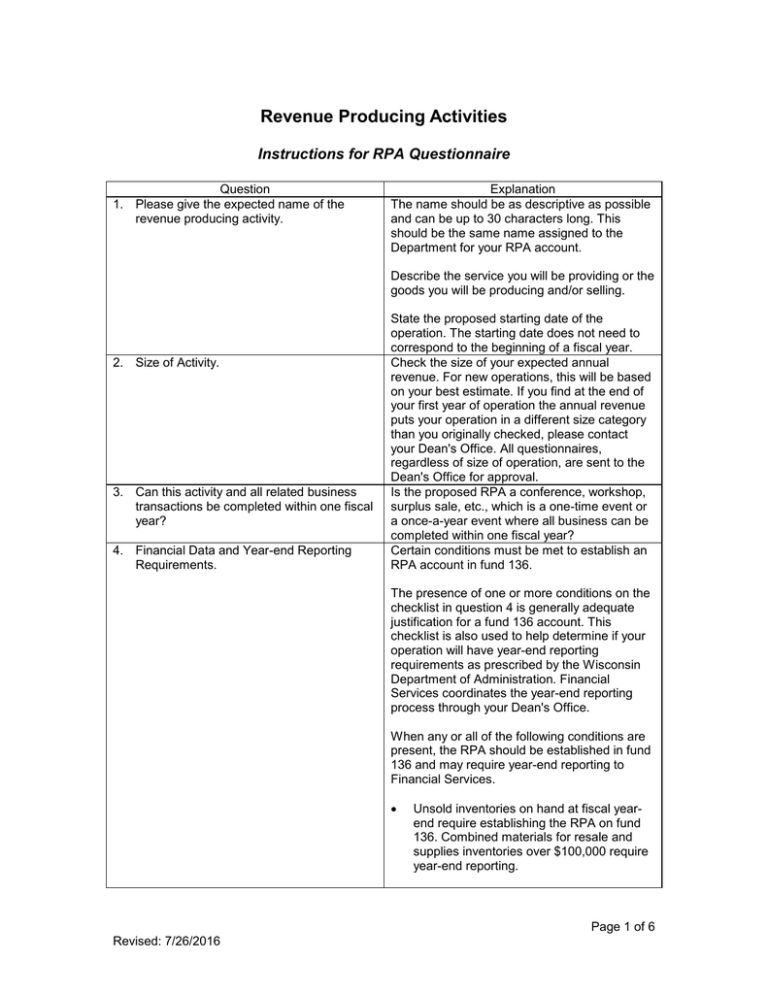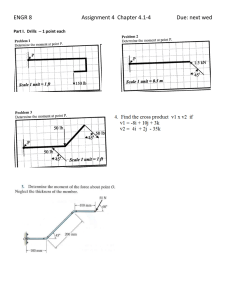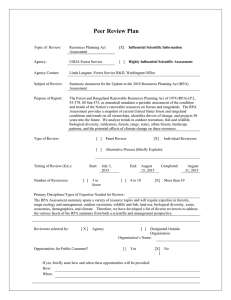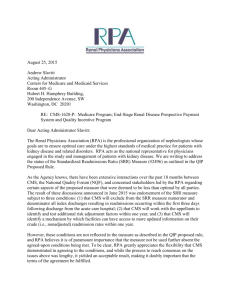Revenue Producing Activities Instructions for RPA Questionnaire
advertisement

Revenue Producing Activities Instructions for RPA Questionnaire Question 1. Please give the expected name of the revenue producing activity. Explanation The name should be as descriptive as possible and can be up to 30 characters long. This should be the same name assigned to the Department for your RPA account. Describe the service you will be providing or the goods you will be producing and/or selling. 2. Size of Activity. 3. Can this activity and all related business transactions be completed within one fiscal year? 4. Financial Data and Year-end Reporting Requirements. State the proposed starting date of the operation. The starting date does not need to correspond to the beginning of a fiscal year. Check the size of your expected annual revenue. For new operations, this will be based on your best estimate. If you find at the end of your first year of operation the annual revenue puts your operation in a different size category than you originally checked, please contact your Dean's Office. All questionnaires, regardless of size of operation, are sent to the Dean's Office for approval. Is the proposed RPA a conference, workshop, surplus sale, etc., which is a one-time event or a once-a-year event where all business can be completed within one fiscal year? Certain conditions must be met to establish an RPA account in fund 136. The presence of one or more conditions on the checklist in question 4 is generally adequate justification for a fund 136 account. This checklist is also used to help determine if your operation will have year-end reporting requirements as prescribed by the Wisconsin Department of Administration. Financial Services coordinates the year-end reporting process through your Dean's Office. When any or all of the following conditions are present, the RPA should be established in fund 136 and may require year-end reporting to Financial Services. Unsold inventories on hand at fiscal yearend require establishing the RPA on fund 136. Combined materials for resale and supplies inventories over $100,000 require year-end reporting. Page 1 of 6 Revised: 7/26/2016 Financial Data and Year-end Reporting Requirements. (continued) 5. Customers 6. User Rates/Prices. User rates/prices. (continued) If your operation has accounts receivable (that is services provided or products sold, but revenue not yet received) at year-end and the money is owed by sources outside the UW System, you will be required to report the accounts receivable amounts. Unearned revenue is revenue received and coded to the current fiscal year, but goods or services will be provided in the next fiscal year. In the UW System accounting records, revenues are recognized when payments are processed regardless of whether earned or not. Unearned revenue balances over $5,000 must be reported at year-end. If your operation will incur expenses in one fiscal year but revenue will be received in the next fiscal year (prepaid expenses) or equipment depreciation is included in your rates, the RPA account should be established in fund 136. The type of customers you expect to serve through the RPA will determine whether you should charge sales tax and whether unrelated business income (UBI) is generated by your operation. Charges to UW departments are not subject to sales tax or unrelated business income tax (UBIT). If you are charging substantial amounts to federally funded grants, you need to be sure that your rate calculations meet federal guidelines. Sales to UW faculty and staff for personal consumption and to students are generally subject to sales tax. Sales to businesses and the general public are subject to sales tax and may generate unrelated business taxable income. Sales tax and UBIT are covered in questions 7, and 11-13. Full documentation of how rates were determined must be prepared for all RPA accounts. When an RPA account is initially set up, it is acceptable to use estimates in determining rates. Rates should be reviewed, recalculated and documented at least once a year using actual costs as a basis for the calculation. Generally the same fund source should be used to record revenues and expenditures in the campus accounting system. For example, if you include salaries in the rate(s) for a fund 136 operation, you should not pay the salaries from another fund source while depositing the revenue to fund 136. If the operation requires a subsidy, Page 2 of 6 Revised: 7/26/2016 expenditures should first be paid out of the fund where the revenue is deposited and then transferred from that fund to the subsidizing fund source as described in the instructions to question 9. Replacement cost of future equipment purchases may not be built into rates, although depreciation on some existing equipment may be included in rates for fund 136 operations. The policies that apply to developing rates differ depending on the type of user/customer. A user/customer is defined as the person, department, company, or organization that is paying for the goods or services. Users/customers are categorized into two types - internal and external. Internal customers include other campus departments or funding sources within the UW System and other Wisconsin state agencies. According to federal guidelines in OMB Circular A-21, sales to internal customers must be priced at or below the selling unit's cost of providing the product or service. Rates must be applied consistently to all internal customers; it is not acceptable to charge different rates to different internal customers. External customers include students, faculty, staff, private organizations (student organizations, non-profits, and alumni associations are considered private organizations as well as typical private sector entities and enterprises), governmental organizations (other than UW System institutions and Wisconsin state agencies), and the general public. In general, products or services sold to customers outside the UW System and excluding Wisconsin state agencies must be priced to recover all of the selling unit's costs of providing the product or service as well as the University's indirect costs as calculated by the University's federal indirect cost rate. For revenue producing activities that potentially are in competition with the private sector refer to the UW System Policy on Competition With the Private Sector, (http://www.uwsa.edu/rpd/rpd89-1.htm), (approved by the UW Board of Regents, February 1990). This policy governs all sales User rates/prices. (continued) of products or services to external customers. Page 3 of 6 Revised: 7/26/2016 The rate calculation process requires careful consideration of all costs associated with providing goods or services for a fee. This is especially important in the RPA will serve federally funded activities where most agreements are for the reimbursement of costs only, and are subject to audit and disallowance by both federal and state auditors. The first step in calculating rates is to identify each cost (both direct and indirect) used in the production of the good or service; then determine what portion of these costs will be recovered through user charges/fees. The two most common cost that make up user fees are labor and materials. 7. Sales tax. After determining the costs to be recovered, identify a method to measure a unit of service (some common measures are time, a test result or a product); then assign costs to that unit. The RPA's staff should discuss the rate calculations, measure and unit of service with their Dean/Director's Office. Document the rates and rate calculations. The simpler the rate calculation, the easier it will be to create and maintain appropriate documentation. If you are selling products or services to customers outside the University, including faculty and staff (as external users/customers) and students, the sales may be subject to Wisconsin sales tax. Sales to certain agencies such as Wisconsin state agencies, public schools, and municipalities are exempt from sales tax as is the sale of items shipped outside of Wisconsin. Non-profit organizations usually qualify for sales tax exemption, but they must supply a Certificate of Exempt Status number. Sales tax generally applies to the sale of "tangible personal property" and generally does not apply to services. However, sales of the following services are taxable: sales of admissions to athletic, entertainment, or recreational events, and fees for the use of recreational facilities. Sales of personal property and services which are subject to state sales tax are also subject to county sales tax if the sale takes place in a county which has adopted the county sales tax. 8. Sale of printed material. If your activity involves the sale of copyrighted material, proper copyright releases must be Page 4 of 6 Revised: 7/26/2016 9. Self supporting or subsidized? obtained from the original publisher before the printing takes place. In general, RPAs should be self-supporting. However, you may choose to subsidize an operation by paying a portion of its costs from another funding source. This is referred to as an operational subsidy. Please identify the fund source which will provide the subsidy and the costs which you are planning to subsidize. The preferred method of accounting for the subsidy is to deposit all revenue to the RPA account, pay all costs related to the activity from the same account, then transfer expenditures on a lump sum basis to the source of the subsidy using the appropriate salary or non-salary payment transfer form. If the RPA is funded or subsidized by extramural funding, please identify the fund/account of the grant, and be sure that written approval has been obtained from the granting agency. When an extramural subsidy is involved, please inform the Office of Research and Sponsored Programs. 10. Bookkeeping responsibility. 11. Regularly carried on. Please identify the funding source which will assume financial responsibility for any year-end deficits. This information must be provided for all RPA accounts, whether or not you are planning to subsidize. Please provide the name and phone number of the person responsible for bookkeeping and budget duties for this operation. For the purposes of defining unrelated business income (UBI), the IRS considers any activity carried on for the production of income from the sale of goods or services to be a "trade or business" as long as there is a profit motive. (if the activity shows a loss for 3 or more years out of the past 5 years there is a presumption of no profit motive.) The "regularly carried on" requirement refers to the frequency and continuity with which the activity is conducted. The tax regulation states that "activities will not be regarded as regularly carried on merely because they are conducted on an annually recurrent basis." Therefore, such events as annual recitals, performances and style shows would not necessarily be considered to generate Regularly carried on. (continued) 12. How does this activity relate to the mission of UW-Platteville and/or departmental unrelated business income. This question is designed to determine if the activity fulfills the "substantially related" Page 5 of 6 Revised: 7/26/2016 objectives? requirement of the Internal Revenue Code. Income from an activity, even though a "trade or business" and "regularly carried on," will not be treated as unrelated business income if the activity is "substantially related" to the mission of the university. The activity is considered substantially related if: 13. Is revenue generated from the sale of advertisements in a University publication, broadcast or event? Students are directly involved in the activity through coursework or as part of a training program; The activity involves primarily the conduct of research (not including mere producttesting); or The activity is directly related to the university's outreach mission. Income from an activity is also exempt from unrelated business income tax if it is conducted for the convenience of faculty, staff, or students. This includes certain retail facilities operated on campus for the accommodation of its students and faculty. Examples include photocopy machines; student dining and snack facilities; hospital cafeterias; operations which sell books, magazines, stationary, student supplies. Revenue from the sale of advertising is considered unrelated business income. Messages that include the following constitute advertising: qualitative or comparative language; price information; a call to action; an endorsement; or an inducement to buy, sell, rent or lease the sponsor's product. However, mere acknowledgement of a corporate name or logo generally is considered to be "corporate sponsorship" as opposed to advertising. Notes to Instructions These instructions are meant to be an assistant in completing the RPA Questionnaire. The explanations are based upon the Policy: Revenue Producing Activities. This policy can be found within the Policies and Procedures section of the Financial Services Resources Web site, http://www.uwplatt.edu/financial/resources. All questions regarding Unrelated Business Income (UBI) and Unrelated Business Income Tax (UBIT) should be directed to Financial Services. Page 6 of 6 Revised: 7/26/2016


